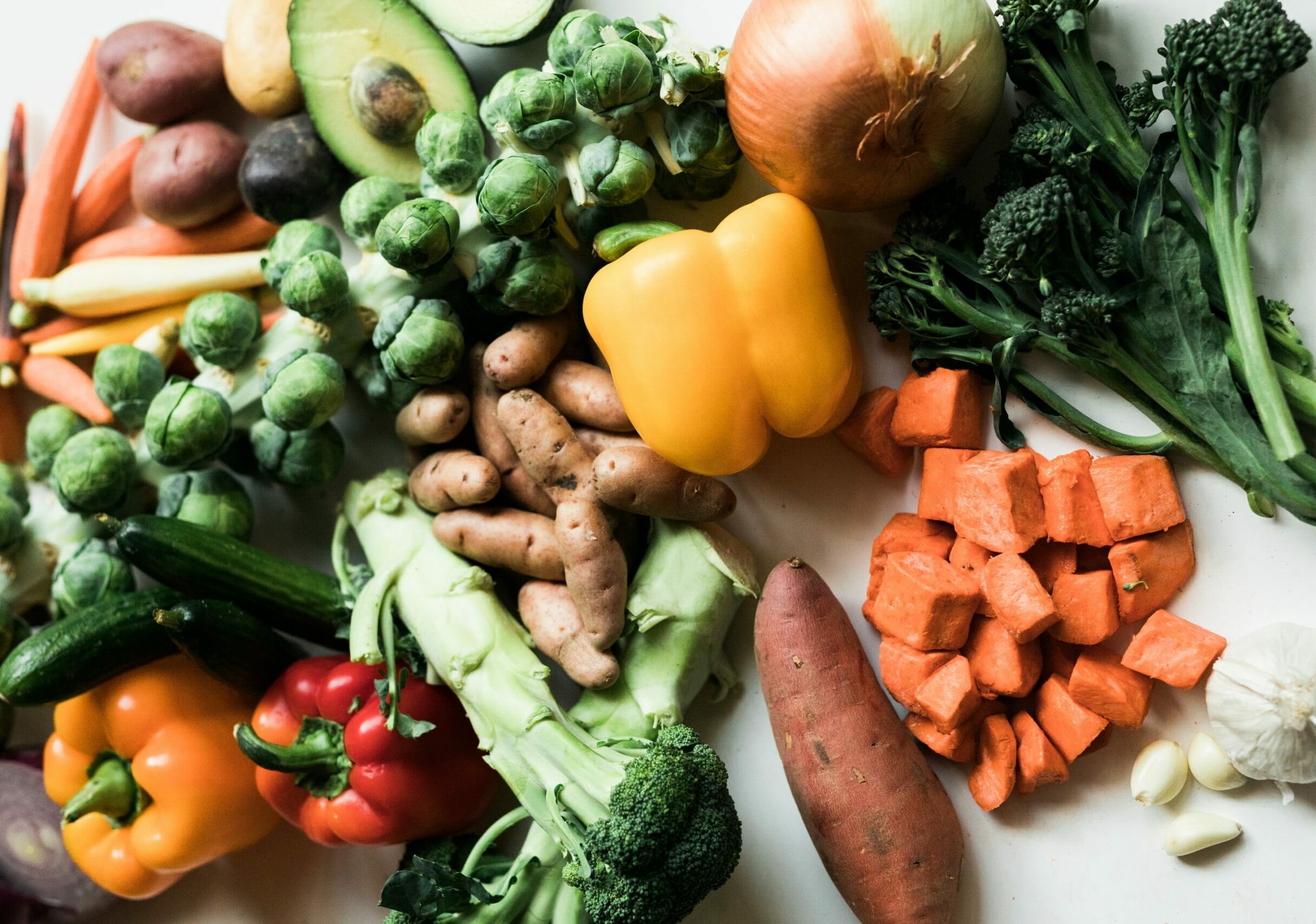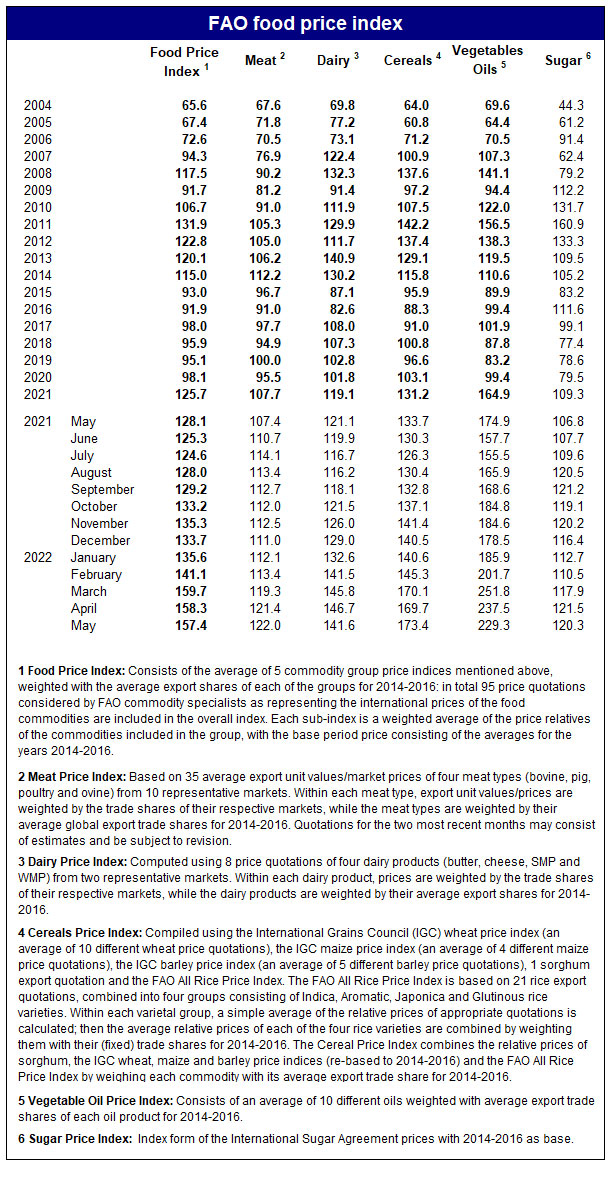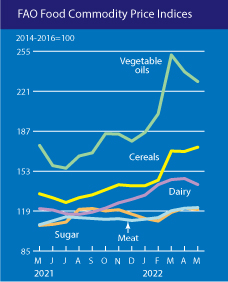How are food prices going?

Here are the prices of food products that rise or fall according to the FAO index. Facts, numbers and forecasts from the World Bank
Globally, commodity prices for food products fell for the second consecutive month in May. This is stated by the United Nations Food and Agriculture Organization (FAO).
However, this is not a real sigh of relief as the FAO World Food Price Index continues to remain close to the level it reached in March which, with the outbreak of the war in Ukraine, peaked since 2011.
THE DATA OF THE FAO INDEX
FAO's World Food Price Index – which measures the monthly change in average prices for meat, dairy, grains, vegetable oils and sugar – fell 0.6% in May from the previous month. In April, the decline was 0.8%.
According to the Organization, the decrease is due to the drop in vegetable oil prices.

THE DROP IN VEGETABLE OIL PRICES
In May, the FAO vegetable oil price index decreased by 3.5% compared to April, while remaining significantly above the level of the previous year.
In particular, the prices of palm, sunflower, soybean and rapeseed oils fell mainly for two reasons: Indonesia lifted its ban on exporting palm oil and demand for global imports of soybean and rapeseed oils was scarce due to the high costs of recent months.
“Export restrictions create uncertainty in the market and can lead to price spikes and increased price volatility; The drop in oilseed prices shows how important it is when they are removed and allow exports to flow smoothly, ”FAO chief economist Máximo Torero Cullen said.
THE WHEAT WAR CONTINUES
Instead, the wheat war continues. In fact, the FAO cereal price index increased by 2.2% compared to the previous month, driven by wheat prices, which grew by 5.6% compared to April and 56.2% compared to the previous month. correspondent a year earlier.
International wheat prices – on average only 11% below the all-time high reached in March 2008 – have risen in response to India's announced export ban and concerns over crop conditions in many major exporting countries. , as well as the difficulties in releasing Ukrainian wheat from the ports that have fallen into the hands of the Russians , which prevent it from being transported.
Spain , due to prohibitive grain prices, has come to use fodder cereals to fill gaps in flour production.
In the United States , wheat futures prices have risen 48% since the start of 2022.
SECONDARY CEREALS AND RICE
FAO also reports that international rice prices have also increased across the board, while prices of coarse grains have fallen by 2.1%, with an even more marked decline in corn prices, following the slight improvement in conditions of crops in the United States, seasonal supplies to Argentina, and the imminent start of the main maize crop in Brazil.
MEAT RECORD
New all-time high for the FAO Meat Price Index, which rose by 0.6% in May, despite world beef prices remaining stable and pork prices declining.
The increase, the report explains, was driven by a sharp rise in international poultry meat prices, reflecting ongoing supply chain disruptions in Ukraine and recent avian flu cases , concurrent with a surge in demand in Ukraine. Europe and the Middle East.
IN COUNTERTEND, DAIRY PRODUCTS …
On the other hand, the prices of dairy products are decreasing. The FAO index indicates a decrease of 3.5% compared to the previous month.
Prices for powdered milk are falling mainly due to closures in China which have reduced demand, while solid retail sales and high demand from restaurants in the Northern Hemisphere have prevented cheese prices from falling significantly despite the weakening of global import demand.
… AND SUGAR ALSO
The FAO sugar price index, the report said, fell by 1.1% compared to April, due to a bountiful harvest in India that boosted the prospects for global availability.
The weakening of the Brazilian real against the US dollar, together with the drop in ethanol prices, has also brought down sugar prices worldwide.

THE FORECASTS OF THE WORLD BANK
Even the forecasts of the World Bank are not rosy, which believes that "the prices of the food and beverage sector will rise this year by 23% (on a world average), in the wake of the growth of 31% in 2021", according to what reported by Milano Finanza .
To weigh are and will be the increase in the costs of raw materials such as fuel, electricity and fertilizers, but also the modest agricultural yields and obviously the continuing Russian invasion of Ukraine, which has an impact both on the supply of food and on prices. replacement products.
This is a machine translation from Italian language of a post published on Start Magazine at the URL https://www.startmag.it/economia/come-vanno-i-prezzi-dei-prodotti-alimentari/ on Fri, 10 Jun 2022 09:22:31 +0000.
